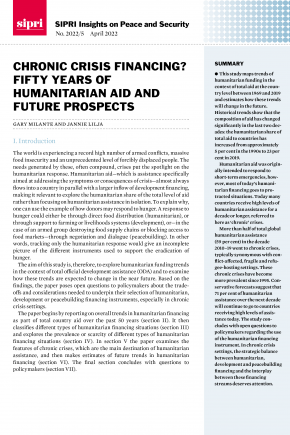Chronic Crisis Financing? Fifty Years of Humanitarian Aid and Future Prospects
This study maps trends of humanitarian funding in the context of total aid at the country level between 1969 and 2019 and estimates how these trends will change in the future. Historical trends show that the composition of aid has changed significantly in the last two decades: the humanitarian share of total aid to countries has increased from approximately 5 per cent in the 1990s to 23 per cent in 2019.
Humanitarian aid was originally intended to respond to short-term emergencies, however, most of today’s humanitarian financing goes to protracted situations. Today many countries receive high levels of humanitarian assistance for a decade or longer, referred to in this paper as ‘chronic’ crises.
More than half of total global humanitarian assistance (59 per cent) in the decade 2010–19 went to chronic crises, typically synonymous with conflict-affected, fragile and refugee-hosting settings. These chronic crises have become more prevalent since 1995. Conservative forecasts suggest that 71 per cent of humanitarian assistance over the next decade will continue to go to countries receiving high levels of assistance today. The study concludes with open questions to policymakers regarding the use of the humanitarian financing instrument. In chronic crisis settings, the strategic balance between humanitarian, development and peacebuilding financing and the interplay between these financing streams deserves attention.
I. Introduction
II. Humanitarian financing trends in context
III. Different types of humanitarian financing situations
IV. Mapping prevalence: The increasing incidence of high humanitarian financing situations
V. Chronic crises: The main destination of humanitarian assistance
VI. Future prospects: Chronic crisis financing continued
VII. Connecting key findings and policy questions
Annex A. Data notes and methodology


